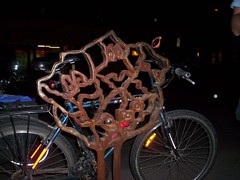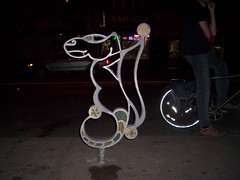Imagine a city where street furniture is designed by psychiatric survivors and artists. It’s a far cry from a city with fully harmonized street furniture covered in advertisements.
Here’s something to help spark your imagination.


The tree and dog sculptures-cum-bike stands were designed by a group of psychiatric survivors who meet at Parkdale Activity and Recreation Centre (PARC) on Tuesdays.
The stand is out in front of PARC. There are, apparently, two more sculptures to be installed this month that incorporate solar panels. But, PARC administrators are trying to figure out how to theft-proof them since someone has taken some marble off of this one.
PARC, along with tangenTs (of 6 St. Joseph House), will be hosting a juried exhibit of “outsider art” on September 30th at the Gladstone Hotel.
From the release:
PARC artists create from a place of “human renewal”, reflecting their experience that urban renewal often excludes those who do not have possessor rights in today’s society. Ultimately, bricks and mortar need renewal but so do people…where can they go when the places they frequent become out of their reach?
The bold emphasis is mine. I wonder if the City would be willing to intentionally seek out the input of psychiatric survivors and outsider artists for its recently-launched Coordinated Street Furniture Program. It has initiated a number of studies and public consultations, available here.
The street furniture program has good intentions to beautify Toronto’s streets, but, as the folks at the Toronto PublicSpace Committee say; “…the project has turned into the biggest public space sell-off we’ve seen so far…â€
As it stands now, citizens of Toronto are more likely to see advertising on their street furniture rather than whimsical and inspiring art.
(See this previous post on the Spacing wire for cool pics of inventive bike racks in Ohio and Whitehorse.)
Photos courtesy of BikingToronto




6 comments
This is really neat to see.
While the Street Furniture Program may mean a unified streetscape – a “signature look” for our newspaper boxes and lampposts and whatnot – I’m not big on the thought of the whole city having the same look from end to end.
Having standards for our street furniture, that’s hardly a bad thing. But *standardizing* it is a different matter. I’d much rather see pieces designed by local artists, like the Style In Progress utility box project, or Intersection Repair in Portland.
I’d love to see a provision in the program to let neighbourhoods decide on their own furniture… or even a bit of money toward helping people (artists, neighbourhood associations, anyone!) to create/improve street furniture. What if there was someone you could go to for advice on bench standards, or on how to make sure your awesome-looking bike loops are theft-proof?
Hmm. A new how-to column for Spacing?
In my fevered imagination I’m seeing a cross between Make magazine and Christopher Alexander’s “A Pattern Language”…
FYI -A City rep just sent me this: “The next opportunity for public consultation will be early in the new year when the joint Planning and Transportation and Works Committee (or their successors) considers the submissions received in response to the RFP.”
Oh and I just talked to Charmaine at PARC and she credits, Phil Sarazen, as being the guy who came up with the whole idea… he is also the metal worker… two more posts to come!
1) As much as everyone would like to believe that a street furniture program could be created without including ad space, the fact is it can’t happen. The ads are what pays for the street furniture, including the pieces that don’t have advertising on them (ie. the bike racks, benches, etc.). As it stands the city will be getting an entirely new, up to date and state of the art system of street furniture worth billions of dollars, for free aka at no cost to tax payers. If there are no ads, who pays for the elements? Who pays for the materials? Who pays the workers/artists who build it? Who pays for the research and development to make sure it doesn’t fall down or fall over and kill somebody.
You may not like ads but the fact is they make your life affordable. They make your magazines cheaper, they make TV, movies, and sports possible, they disseminate important public information, and they ensure a fair and competitive marketplace.
2)Why does everything have to be coordinated? Because if it isn’t, then everything is a custom, one-off piece, which means drastically increased prices, and therefore an even greater burden on taxpayers (since we’ve already determined we don’t want any ads). Think of it in terms of a new car. If you go into a dealership you might get a car for $30,000. If you go to a mechanic and have him build that same car from scratch, it’ll cost you ten times as much. If you also have him build all it’s component pieces from scratch, it will cost 100 times the price. Cars are built on an assembly line and therefore all look essentially the same, because they use all the same pieces and can be built in exactly the same way, and require research and development investments only once. The same principles apply to making an affordable street furniture system. It’s simple math.
3) Why can’t everything be made with flair and personality? Because not everyone would like it or, more importantly, be able to live with it. What artistic style would you choose? How would you choose it? What if I can’t stand that style but everyday I have to walk out my front door and see it everywhere? Elements presented as part of the public space must be designed in the least potentially offensive way, because everyone has to live with them. Yes they may at times be a little bland, or uninteresting but that’s the point, they’re supposed to be essentially invisible in the public eye and not attract attention away from private businesses or residential streetscapes. Maybe you want the city to look like a curly, twirly scene from the Alice in Wonderland but not everybody does.
You live in a community, remember that.
…and no I’m not an advertiser and no my company does not design street furniture. I’m just a designer who’s tired of hearing this comment over and over again.
“As much as everyone would like to believe that a street furniture program could be created without including ad space, the fact is it can’t happen.”
Happened for centuries, actually.
“You may not like ads but the fact is they make your life affordable.”
In fact, research shows that advertising constitutes a significant portion of the end price of purchased items.
“Why does everything have to be coordinated…”
…oh man. I give up. There’s just too much to refute in this comment.
Then, if you can’t refute what he said, don’t reply to his comment. He came up with a point that that is logical and correct, not a farrago of bullshit that can’t be sustained in reality.